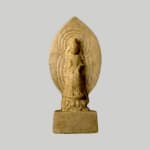Northern Wei Marble Sculpture of a Bodhisattva, 386 CE - 534 CE
Marble
height 29.2 cm
height 11 1/2 in
height 11 1/2 in
LO.1310 (AM)
Further images
This marble stele depicts a bodhisattva carved in high relief against a leaf-shaped mandorla. It dates to a time of unprecedented artistic development that surrounded the period of China’s unification...
This marble stele depicts a bodhisattva carved in high relief against a leaf-shaped mandorla. It dates to a time of unprecedented artistic development that surrounded the period of China’s unification in 439 AD, under the Northern Wei (or Tuoba Wei). The rulers of the dynasty seem to have originated from the Tuoba clan of the non-Han Xianbei tribe, and later renamed themselves the Yuans.
Standing on a lotus pedestal, the figure wears a tall headdress and a flowing outer robe which runs beneath the pedestal onto the rectangular plinth. In his right hand he holds a lotus bud and in his left a heart-shaped fan. These attributes are common amongst bodhisattvas of the Northern Wei period. The fan motif first appears in a similar context in Gandharan Buddhist art of the 1st century AD and was used to honour high-ranking persons. In Chinese examples it is always shown pointing downwards. Two sets of concentric curves have been carved in low relief to frame the bodhisattva. Delicate features are one of the hallmarks of Northern Wei figurative sculpture, reflected here in the slender arms and body. The face and clothing are likewise finely carved, with a long robe and tunic surmounted by a flamboyant piece of headwear that frames the face with two “wings”.
Buddhism was first introduced to China from the Indian subcontinent along the trade routes of Central Asia during the early years of the Han dynasty. However it faced two powerful competing ideologies, Confucianism and Daoism, which initially impeded its progress. When the Northern Wei, a foreign nomadic people, conquered parts of China in the late fourth century Buddhism was flourishing. Bodhisattvas were often depicted in pairs around a central image of the Buddha. These enlightened beings choose to delay their entry into Nirvana in order to help others attain enlightenment. Although Buddhist texts do not specify their gender, Chinese examples are generally depicted as male until the end of the Song Dynasty (1279), when they begin to assume a feminine appearance. Bodhisattvas can usually be differentiated from Buddha figures on the basis of their decorative appearance; Buddhas are invariably depicted in plainer raiment that reflects their ascetic lifestyle.
The size of this piece suggests that it may have functioned in a domestic setting as an aid to devotional reflection. Although there is no remaining trace of colour, it was probably polychromed and gilded in its original state. At this early date bodhisattvas tended not to be venerated in isolation from images of the Buddha, so it is not inconceivable that this piece was once part of a group of free-standing sculptures. The choice of material is also worthy of mention: marble is uncommon, as the majority of Buddhist art that survives from this period is carved from limestone. The small, intimate scale of this piece and the delicacy of the carving make it a truly desirable object. (AM)
Standing on a lotus pedestal, the figure wears a tall headdress and a flowing outer robe which runs beneath the pedestal onto the rectangular plinth. In his right hand he holds a lotus bud and in his left a heart-shaped fan. These attributes are common amongst bodhisattvas of the Northern Wei period. The fan motif first appears in a similar context in Gandharan Buddhist art of the 1st century AD and was used to honour high-ranking persons. In Chinese examples it is always shown pointing downwards. Two sets of concentric curves have been carved in low relief to frame the bodhisattva. Delicate features are one of the hallmarks of Northern Wei figurative sculpture, reflected here in the slender arms and body. The face and clothing are likewise finely carved, with a long robe and tunic surmounted by a flamboyant piece of headwear that frames the face with two “wings”.
Buddhism was first introduced to China from the Indian subcontinent along the trade routes of Central Asia during the early years of the Han dynasty. However it faced two powerful competing ideologies, Confucianism and Daoism, which initially impeded its progress. When the Northern Wei, a foreign nomadic people, conquered parts of China in the late fourth century Buddhism was flourishing. Bodhisattvas were often depicted in pairs around a central image of the Buddha. These enlightened beings choose to delay their entry into Nirvana in order to help others attain enlightenment. Although Buddhist texts do not specify their gender, Chinese examples are generally depicted as male until the end of the Song Dynasty (1279), when they begin to assume a feminine appearance. Bodhisattvas can usually be differentiated from Buddha figures on the basis of their decorative appearance; Buddhas are invariably depicted in plainer raiment that reflects their ascetic lifestyle.
The size of this piece suggests that it may have functioned in a domestic setting as an aid to devotional reflection. Although there is no remaining trace of colour, it was probably polychromed and gilded in its original state. At this early date bodhisattvas tended not to be venerated in isolation from images of the Buddha, so it is not inconceivable that this piece was once part of a group of free-standing sculptures. The choice of material is also worthy of mention: marble is uncommon, as the majority of Buddhist art that survives from this period is carved from limestone. The small, intimate scale of this piece and the delicacy of the carving make it a truly desirable object. (AM)





